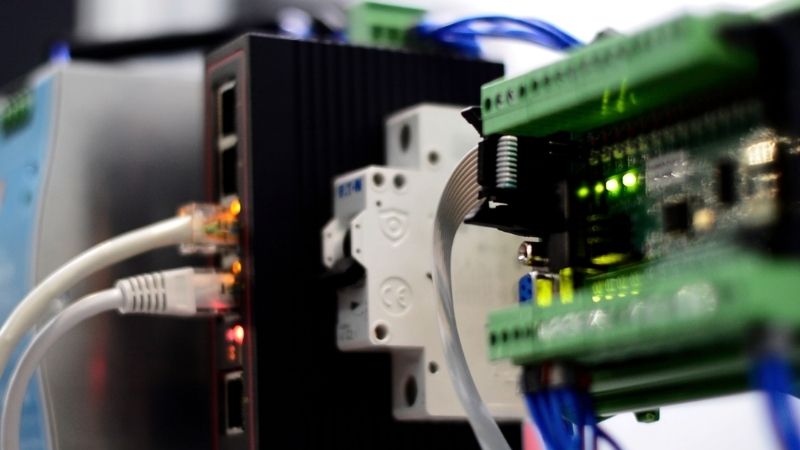Intrare și ieșire analogică PLC: Ghid de testare și depanare
În acest articol, vom aborda intrările și ieșirile analogice ale PLC - componente cheie care permit PLC-uri să gestioneze semnalele și să controleze cu acuratețe procesele. Dacă lucrați cu sisteme de automatizare, înțelegerea modului în care funcționează aceste semnale și cum să le testați este crucială pentru menținerea eficienței și a fiabilității.
Cuprins
Ce sunt intrările și ieșirile analogice ale PLC?
Ce este mai exact o intrare analogică într-un sistem PLC?
O intrare analogică într-un PLC este un semnal care oferă o gamă continuă de valori, spre deosebire de un semnal digital care este binar (fie 0, fie 1). Intrările analogice sunt folosite pentru a primi date de la dispozitive externe, cum ar fi senzori de temperatură, senzori de presiune sau debitmetre. Aceste dispozitive scot un semnal analogic (de exemplu, 0 la 10V, 4-20mA) pe care PLC-ul îl poate procesa pentru a controla sau monitoriza procesele industriale.
Dispozitive de intrare analogice cheie
- Senzori de temperatura (de exemplu, termocupluri, RTD-uri)
- Senzori de presiune
- Debitmetre
- Senzori de nivel
Acești senzori convertesc parametrii fizici (cum ar fi presiunea, temperatura sau debitul) în semnale electrice la care PLC-ul le poate citi, interpreta și reacționa.
Care este funcția ieșirii analogice în PLC-uri?
Pe de altă parte, ieșirea analogică permite PLC-ului să trimită semnale variabile continue către dispozitive de control precum actuatoare, supape și viteză variabilă conduce (VSD-uri). De exemplu, PLC-urile pot folosi ieșiri analogice pentru a controla motor viteze, elemente de încălzire sau alte dispozitive care necesită un control fin asupra valorii de intrare.
Ieșirea analogică poate fi sub formă de curent (de obicei 4-20mA) sau tensiune (0-10V). PLC-ul traduce valoarea de ieșire dorită într-un semnal analogic corespunzător pe care dispozitivul conectat îl poate înțelege și la care poate răspunde.
Dispozitive de ieșire analogică cheie
- Unități cu viteză variabilă (VSD)
- Actuatoare
- Încălzitoare
Cum funcționează intrările analogice PLC?
Cum este conectat semnalul de intrare analogic la un PLC?
Pentru a procesa un semnal de intrare analogic, PLC-ul necesită un modul de intrare analogic care convertește semnalul de tensiune sau curent de intrare într-o formă pe care CPU-ul PLC-ului o poate procesa.
De exemplu, un semnal de curent de 4-20 mA va fi primit de modulul de intrare al PLC-ului, care îl va converti apoi într-o valoare digitală pe care PLC-ul o poate folosi în scopuri de control.
Cum interpretează PLC-ul semnalele analogice?
Când semnalul de intrare analogic este recepționat, PLC utilizează un modul convertor (ADC – Convertor analog-digital) pentru a traduce semnalul analogic într-o valoare digitală. Această valoare digitală este apoi utilizată în programarea PLC-ului pentru a lua decizii sau a lua acțiuni, cum ar fi activarea unei alarme sau reglarea vitezei unui motor.
De exemplu, dacă un senzor de temperatură emite un semnal de la 0 la 10V, PLC-ul citește tensiunea și, pe baza unei programari predefinite, o interpretează ca reprezentând un interval specific de temperatură.
Care este rolul ieșirii analogice în sistemele PLC?
Cum controlează ieșirile analogice PLC dispozitivele?
Odată ce PLC-ul a primit date de intrare, poate folosi ieșiri analogice pentru a controla dispozitivele. De exemplu, un PLC poate prelua date de la o intrare analogică, le poate procesa și apoi trimite un semnal analogic corespunzător pentru a controla un dispozitiv, cum ar fi o supapă sau un motor. Această buclă de feedback continuă asigură că procesul se desfășoară fără probleme și eficient.
Ieșirile analogice sunt cruciale în aplicațiile care necesită un control precis, cum ar fi reglarea temperaturii, controlul vitezei motoarelor sau chiar reglarea presiunii într-un sistem de conducte.
Cum este generat un semnal analogic de ieșire?
Semnalul de ieșire analogic este de obicei generat de un modul DAC (convertor digital în analog) din interiorul PLC-ului.
Software-ul PLC trimite o valoare digitală către DAC, care o convertește într-un semnal continuu - fie o ieșire de curent (4-20 mA) fie de tensiune (0-10 V). Acest semnal este apoi transmis dispozitivului de control.
Cum se testează eficient semnalele analogice PLC?
Care este cel mai bun mod de a testa semnalele analogice de intrare și ieșire PLC?
Testarea semnalelor analogice PLC este esențială pentru a verifica dacă sistemul dumneavoastră funcționează corect. Iată cum puteți proceda:
Testarea intrărilor analogice:
- Utilizați un multimetru pentru a măsura semnalul de intrare de la senzor la terminalul de intrare PLC. Verificați că tensiunea sau curentul se află în intervalul așteptat (de exemplu, 4-20mA sau 0-10V).
- Simulați semnalele de intrare folosind un generator de semnal sau un simulator. Acest lucru ajută la asigurarea că PLC-ul răspunde corect la diferite valori.
Testarea ieșirilor analogice:
- Utilizați un contor de tensiune sau curent pentru a măsura ieșirea de la terminalul de ieșire analogic al PLC-ului.
- De asemenea, puteți utiliza un tester de buclă pentru a simula ieșirea și a verifica conexiunea.
Testarea semnalelor analogice asigură că sistemul PLC citește cu acuratețe intrările și generează ieșirile potrivite, ceea ce este crucial pentru menținerea operațiunilor bune în procesele industriale.
Cum știu dacă PLC-ul funcționează corect?
Pentru a verifica dacă PLC-ul procesează semnalele cu acuratețe, puteți verifica programul PLC pentru scalarea și calibrarea corespunzătoare. De exemplu, asigurați-vă că intervalul semnalului de intrare (0-10V sau 4-20mA) corespunde specificațiilor senzorului.
În plus, puteți testa răspunsul PLC-ului ajustând manual intrarea analogică și confirmând că ieșirea analogică corespunzătoare se modifică conform așteptărilor.
Probleme frecvente cu I/O analog PLC și cum să le rezolvi
De ce nu citește corect intrarea mea analogică PLC?
O problemă comună cu intrările analogice este interferența semnalului, care poate distorsiona semnalul de intrare și poate duce la citiri inexacte. Acest lucru poate fi cauzat de zgomot electric, cablare necorespunzătoare sau senzori defecte. Pentru a rezolva această problemă:
- Ecranați cablajul pentru a preveni interferențele.
- Asigurați împământarea corespunzătoare a senzorului și a PLC-ului.
- Înlocuiți senzorii sau cablurile defecte.
Cum depanez problemele de ieșire analogică?
Dacă ieșirea analogică nu se comportă conform așteptărilor, problema ar putea fi la modulul DAC, cablarea sau dispozitivul conectat. Verificați următoarele:
- Asigurați-vă că cardul de ieșire este așezat corect.
- Verificați conexiunea dintre PLC și actuator sau dispozitiv.
- Verificați dacă există cablaje defecte sau conexiuni slăbite.
Întrebări frecvente
Care este diferența dintre intrarea analogică și ieșirea analogică în PLC-uri?
Intrarea analogică este folosită pentru a primi semnale continue de la senzori, în timp ce ieșirea analogică este folosită pentru a trimite semnale continue pentru a controla dispozitive precum actuatoare sau motoare.
Cum pot testa semnalele analogice PLC fără un multimetru?
Puteți utiliza un simulator de semnal pentru a simula semnalele analogice și pentru a verifica răspunsul PLC-ului pentru a verifica dacă funcționează corect.
De ce tensiunea de pe intrarea mea analogică nu este stabilă?
Acest lucru se poate datora interferențelor provenite de la echipamentele din apropiere, a conexiunilor slăbite sau a unui senzor defectuos. Asigurați-vă că toate conexiunile sunt sigure și încercați să ecranați cablurile.
Cum pot simula un semnal analogic pentru testare?
Puteți utiliza un generator de semnal pentru a simula diferite niveluri de intrare analogice (de exemplu, 0-10V sau 4-20mA) și pentru a verifica modul în care PLC-ul procesează aceste semnale.
Alimentați-vă proiectele cu PLC Omron, Mitsubishi, Schneider nou-nouț, original – în stoc, gata acum!
Concluzie
- Intrarea analogică PLC permite sistemului să primească semnale continue de la senzori, în timp ce ieșirea analogică trimite semnale de control continue către dispozitive.
- Testarea regulată a semnalelor analogice PLC asigură citiri și răspunsuri precise din partea sistemului.
- Depanarea I/O analogică implică verificarea interferențelor, cablarea defectuoasă și asigurarea configurației corecte a programului PLC.
- Cablajul, ecranarea și calibrarea corespunzătoare sunt cruciale pentru operațiuni analogice fiabile.
Prin înțelegerea și întreținerea sistemelor dvs. analogice PLC, puteți optimiza procesele de automatizare, puteți reduce erorile și puteți îmbunătăți fiabilitatea generală a sistemului.
Căutați PLC-uri noi, originale pentru proiectele dvs.? La Kwoco, stocăm cele mai noi PLC-uri de la mărci de top precum Omron, Mitsubishi, și Schneider. Cumpărați cu încredere - livrare rapidă, calitate garantată! Cumpărați acum
Contactaţi-ne
Doar completați numele dvs., adresa de e-mail și o scurtă descriere a solicitării dvs. în acest formular. Vă vom contacta în termen de 24 de ore.
Categoria de produs
Produse de vânzare fierbinte
De asemenea, puteți găsi aceste subiecte interesante

Care este diferența dintre PLC, SCADA și DCS?
În domeniul automatizării industriale, selectarea sistemului de control potrivit este crucială. Cu toate acestea, diferențele dintre PLC, SCADA și DCS provoacă adesea confuzie. În calitate de inginer care a lucrat la Kwoco de mulți ani, înțeleg importanța acestor termeni.

NC vs CNC: înțelegerea diferențelor dintre mașinile NC și CNC
Acest articol se scufundă în lumea mașinilor NC (Control numeric) și CNC (Control numeric computerizat), explicând diferențele cheie ale acestora și de ce sunt esențiale în industria automatizării industriale. Indiferent dacă sunteți un profesionist experimentat sau nou în domeniu, această piesă vă va oferi informații valoroase despre modul în care aceste tehnologii au revoluționat producția și despre ce le face să merite înțelese.

Înțelegerea motoarelor CNC pentru ax: un ghid complet
Motoarele cu ax CNC sunt inima mașinilor cnc, permițând precizie și eficiență în producția modernă. Indiferent dacă sunteți un mecanic experimentat sau sunteți doar curios despre modul în care funcționează aceste mașini, acest ghid cuprinzător va face lumină asupra rolului critic al motoarelor cu ax în tehnologia CNC.






